|
 are acknowledged, affirmed and commemorated.
|
Posted on 01/02/2003 5:38:45 AM PST by SAMWolf
|
 are acknowledged, affirmed and commemorated.
|

| Our Mission: The FReeper Foxhole is dedicated to Veterans of our Nation's military forces and to others who are affected in their relationships with Veterans. We hope to provide an ongoing source of information about issues and problems that are specific to Veterans and resources that are available to Veterans and their families. In the FReeper Foxhole, Veterans or their family members should feel free to address their specific circumstances or whatever issues concern them in an atmosphere of peace, understanding, brotherhood and support.
|
|
|
|
(MSTS) In February 1951 the Military Sea Transportation Service (MSTS) aircraft carrier Windham Bay, was the first large ship to navigate the Long Tam River since 1925. While the ship was docked at Saigon (French Indochina) 17 hand grenades were tossed at the ship by terrorists. 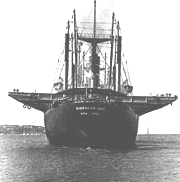 SS Overseas Rose with landing barges lashed across her deck MSTS took about 100 Victory ships out of the National Defense Reserve Fleet (mothball fleet), repaired them, and assigned them to private companies for operation to carry ammunition across the Pacific. MSTS carried guns, tanks, trucks, trains, riverboats, barges, helicopters, bombers, fighters, reconnaissance planes, food, fuel, and medical supplies. By 1965 MSTS had 300 freighters and tankers supplying Vietnam, with an average of 75 ships and over 3,000 merchant mariners in Vietnamese ports at any time. Early in the Vietnam War, troop ships such as the USNS Upshur, Geiger, and Gordon carried two thirds of U.S. troops to Vietnam; later, most American troops traveled by air. However, Korean troops were transported by MSTS throughout the war, with the first 2,000 coming on the MSTS Mann in March 1965. In August 1966 USNS Patch and Darby carried troops 12,500 miles from Boston to Vietnam, the longest trooplift in U.S. military history. In October 1966 the converted Liberty ship SS Benjamin Chew and the SS Meredith Victory were added as troop carriers. Men and equipment of the Army 1st Cavalry Division went to Vietnam aboard the baby flattops USNS Kula Gulf and Point Cruz which were taken out of mothballs to transport the 434 aircraft and other equipment. Other escort carriers which saw WWII duty included the USNS Core, Card, Croatan, and Breton. Da Nang harbor was the home of the Marine Amphibious Force Logistic Command which handled the gear necessary to support 81,000 Marines. MSTS brought 96% of their war materiel including tanks, airplanes, ammunition, and food -- including ice cream. 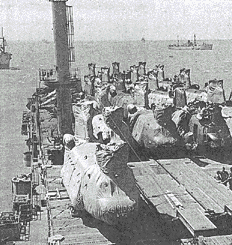 USNS Point Cruz loaded with CH-47 helicopters, F-5 fighters and truck trailers in 1968 Between 1965 and 1969, MSTS carried 7.6 million tons of supplies for the Air Force, about half going directly to Vietnam, the rest to staging areas in the Pacific. MSTS delivered the goods "Special Express" and kept some of its 19 ammunition ships anchored offshore near combat areas as floating warehouses to ease storage problems experienced by the Air Force. SEA Express was the name of the program which delivered other Air Force supplies from Oakland, California to Saigon between 1965 and 1967, in an average of 23 days. 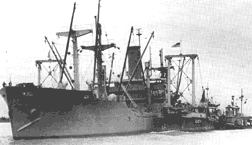 Damaged SS Baton Rouge Victory under tow In 1965, US Coast Guard Squadron One, composed of 17 patrol boats was sealifted to the Philippines for Vietnam duty on the SS Pioneer Myth, SS Transcaribbean, SS Aloha State, and the SS Ocean Cloud. MSTS delivered bulldozers, cranes, steel and cement for use by Navy Seabees. MSTS and the Merchant Marine transported oil and aviation gas to support Navy fleet operations. In 1968 MSTS sealifted 19 million tons (39 billion pounds) of cargo to Vietnam for the Army at a cost of $570 million. The MSTS Corpus Christi Bay, which housed an Army aviation-maintenance battalion, was positioned as necessary along the coast of Vietnam to provide aircraft maintenance facilities. MSTS and chartered ships delivered to many ports in Vietnam during this "War Without a Front." The following were among the 46 precautions to be taken by the crew of the SS President Garfield (and other ships) during the particularly hazardous 35 mile river transit to Saigon:
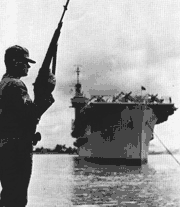 Security for arrival of the USNS Core in Saigon, whose sister ship, USNS Card, was sunk in 1964 by a mine placed by skin divers Just as in World War II and Korea, merchant mariners in Vietnam were subject to the Uniform Code of Military Justice. Effective December 1966, the military was granted authority to take disciplinary action against merchant mariners. In 1975 MSTS helped evacuate refugees from Da Nang and later, Saigon. On March 28, 1975 the Pioneer Commander, the Pioneer Contender and the Navy's U.S.S. Miller evacuated about 10,000 refugees each. Returning the next day when the Communists had already overrun Da Nang, the ships evacuated thousands more. On May 12, 1975, the SS Mayaguez was seized by Kmer Rouge. US marines suffered heavy casualties during the attempted rescue of the 39 seamen and the ship. Six mariner volunteers from the USNS Greenville Victory received Merchant Marine Distinguished Service Medal for their role during the action. Capture and Release of SS Mayaguez by Khmer Rouge forces in May 1975. 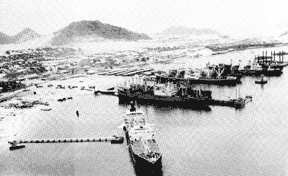 Harbor at Cam Ranh Bay A Special Thanks to Dan and Toni Horodysky, Who so graciously allowed me permission to use the information on their Site.
|
Yes, it's a shame that 'a large portion of that world' finds itself at odds with us. So much so, that they are trying their best to whittle down the point spread.
Two veteran related stories in the newspaper this morning:
State issued 442 honorary high school diplomas to vets in 2002
RICHMOND, Va. (AP) _ The Virginia Board of Education issued 442 honorary high school diplomas last year to veterans who were unable to finish their education because of their military service.
and
Bedford financial accord at hand? D-Day Memorial lawyer optimistic
Officials at the National D-Day Memorial Foundation in Bedford hope for good tidings in the new year, and an answer to the organization's ongoing financial woes.
Happy New Year to all our Vets and their loved ones!

Today's classic warship. USS Idaho (BB-24)
Mississippi class battleship
Displacement. 13,000 t.
Length. 382'
Beam. 77'
Draft. 24'8"
Speed. 17 k.
Complement. 744
Armament. 4 12", 8 8", 8 7", 12 3", 2 21" tt.
The USS Idaho (BB-24) was launched by William Cramp & Son's, Philadelphia, 9 December 1905; sponsored by Miss Louise Gooding, daughter of the Governor of Idaho; and commissioned at Philadelphia Navy Yard 1 April 1908, Captain S. W. B. Diehl in command.
The new battleship conducted a shakedown cruise to Cuba April-May 1908, and after a visit to Panama returned to Philadelphia for alterations. The ship took part in the giant naval review in Hampton Roads 22 February 1909 celebrating the return of the Great White Fleet from its around the world cruise. In March she returned to the Caribbean for maneuvers, continuing to take part in training operations until October 1910. Idaho sailed 29 October for exercises in British and French waters, and upon her return participated in gunnery exercises in Chesapeake Bay 19 to 28 March 1911.
Idaho sailed from Philadelphia 4 May 1911 for a cruise up the Mississippi River to Louisiana ports. She then steamed to the east coast of Florida for battleship maneuvers, and continued to operate off the coast and in the Caribbean until entering the reserve at Philadelphia 27 October 1913.
There she remained until 9 May 1914, when the ship sailed to the Mediterranean with midshipmen for at sea training. After visiting various ports in North Africa and Italy and carrying out a rigorous training program, Idaho arrived Villefranche 17 July 1914, transferred her crew to the USS Maine, and decommissioned 30 July. She was turned over to the government of Greece, whom she served as coastal defense ship Lemnos until being sunk in Salamis harbor by German aircraft in April 1941.
SAMWolf, I think you would like this version of the USS Idaho even better.

Finally an Idaho I'm familiar with!
|
Medical Civilian Assistance Program (MEDCAP)
 Lt. Col. Katharine Opitz, of Fort Lewis, Wash., examines an elderly woman during an operation of Medical Civilian Assistance Program (MEDCAP) Thursday Jan. 2, 2003 at Mero Gul Village, near Kandahar, Afghanistan. The U.S. Army based in Kandahar Air Fields regularly carries out this program in nearby villages. (AP  Girls watch U.S. soldiers with a Humvee in background, during an operation of Medical Civilian Assistance Program (MEDCAP) Thursday Jan. 2, 2003 at Mero Gul Village, near Kandahar, Afghanistan  Capt. Isaac Kim, Houston, Texas, left, examines a baby with skin infection during an operation of Medical Civilian Assistance Program (MEDCAP) Thursday Jan. 2, 2003 at Mero Gul Village, near Kandahar, Afghanistan.  A soldier picks up packs of Humanitarian Daily Ration to give away to villagers during an operation of Medical Civilian Assistance Program (MEDCAP) Thursday Jan. 2, 2003 at Mero Gul Village, near Kandahar, Afghanistan
|
R.I.P. Joe
Disclaimer: Opinions posted on Free Republic are those of the individual posters and do not necessarily represent the opinion of Free Republic or its management. All materials posted herein are protected by copyright law and the exemption for fair use of copyrighted works.